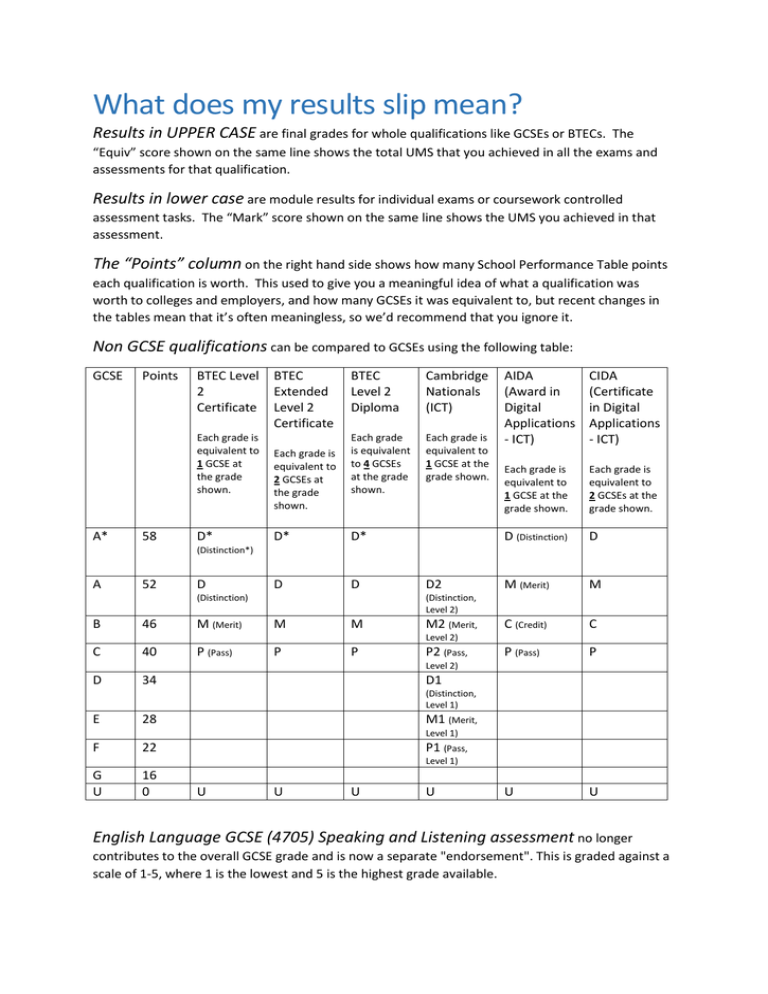Wilmslow High...What does my results slip mean?
advertisement

What does my results slip mean? Results in UPPER CASE are final grades for whole qualifications like GCSEs or BTECs. The “Equiv” score shown on the same line shows the total UMS that you achieved in all the exams and assessments for that qualification. Results in lower case are module results for individual exams or coursework controlled assessment tasks. The “Mark” score shown on the same line shows the UMS you achieved in that assessment. The “Points” column on the right hand side shows how many School Performance Table points each qualification is worth. This used to give you a meaningful idea of what a qualification was worth to colleges and employers, and how many GCSEs it was equivalent to, but recent changes in the tables mean that it’s often meaningless, so we’d recommend that you ignore it. Non GCSE qualifications can be compared to GCSEs using the following table: GCSE Points BTEC Level 2 Certificate Each grade is equivalent to 1 GCSE at the grade shown. A* 58 D* BTEC Extended Level 2 Certificate Each grade is equivalent to 2 GCSEs at the grade shown. BTEC Level 2 Diploma Cambridge Nationals (ICT) Each grade is equivalent to 4 GCSEs at the grade shown. Each grade is equivalent to 1 GCSE at the grade shown. D* D* D D AIDA (Award in Digital Applications - ICT) CIDA (Certificate in Digital Applications - ICT) Each grade is equivalent to 1 GCSE at the grade shown. Each grade is equivalent to 2 GCSEs at the grade shown. D (Distinction) D M (Merit) M C (Credit) C P (Pass) P U U (Distinction*) A 52 D (Distinction) B 46 M (Merit) D2 (Distinction, Level 2) M M M2 (Merit, Level 2) C 40 P (Pass) P P P2 (Pass, Level 2) D 34 D1 (Distinction, Level 1) E 28 M1 (Merit, Level 1) F 22 P1 (Pass, Level 1) G U 16 0 U U U U English Language GCSE (4705) Speaking and Listening assessment no longer contributes to the overall GCSE grade and is now a separate "endorsement". This is graded against a scale of 1-5, where 1 is the lowest and 5 is the highest grade available. FSMQ (OCR Advanced Level Free-Standing Mathematics Qualification: Additional Mathematics) These are equivalent to two-thirds of a GCSE but as they are harder they are worth more points. FSMQ Grade Performance Points A B C D E 45 40 35 30 25 Accounting for the smaller size of this qualification it would be equivalent to the following points if "full sized": GCSE equivalence: 67.5 60 52.5 45 37.5 Well over GCSE A* Slightly over GCSE A* Slightly over GCSE A Slightly under grade B Half a grade less than grade C What is UMS? (Information taken from the AQA website: search the web for “UMS” and the name of an exam board to find out more: the AQA site has some really helpful tools and notes) The Uniform Mark Scale (UMS) is a way of turning the raw marks achieved in a unit in a particular sitting into a mark that can be used to compare with those achieved in other series. The UMS balances out differences between exams and is a way of making sure people get the correct grade, no matter when they took a particular unit. UMS marks from all the units are then added together to give you an overall mark for your qualification. Let's say, for example, that Chris takes an exam for a particular unit in January while Ali takes that unit in June. Because the exam questions will be different between the January and June sittings, it is possible that one exam might be slightly more difficult than the other. If both students got a raw mark of 42/50 on their exams, but the June exam was more difficult than the January sitting, then their marks wouldn't represent the same level of achievement. The UMS mark would reflect this. The UMS grade boundaries for GCSE are fixed as follows: A* = 90% of the max UMS C = 60% F = 30% A = 80% D = 50% G = 20% B = 70% E = 40% The maximum UMS is different for different subjects and exam boards. The quickest way to find out is to do a web search for “UMS” and the Board and Element Code from your results slip for the subject you want to know about. Any urgent queries should be addressed to Mr Haigh or Mrs Cotton on results day. You can contact us through the following email addresses or through the school switchboard as well, but please try to use the exam board websites to find the answers to your questions first if possible. dhaigh@wilmslowhigh.org scotton@wilmslowhigh.org Forms for post-results services (review of marking, copies of scripts etc.) can be found at www.wilmslowhigh.com/examinations/




